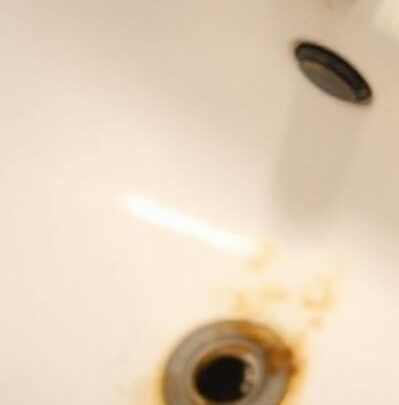Mold can grow in water pipes, especially when moisture, organic debris, and low flow allow mold spores to settle and spread. Although mold doesn’t grow directly in water, it thrives on the inner surfaces of pipes, drains, and fittings where damp conditions persist.
In this guide, learn what causes mold in pipes and how you can test for its presence.
If you suspect mold problems in your supply pipes, contact Tip Top Plumbing & Restoration at 954-289-3110 for professional inspection and removal. We serve Pembroke Pines, FL, and neighboring areas.
What Causes Mold in Your Plumbing?
Mold forms in pipes when the right conditions allow spores to settle and multiply. Below are the most common causes of mold growth inside your residential water system:
Low or Infrequent Water Flow
When water sits still in unused pipes, it creates damp surfaces that support mold growth. Guest bathrooms, seasonal homes, and infrequently used fixtures are especially prone to this issue.
Organic Buildup Inside Plumbing
Soap, grease, and food debris can accumulate in the bends of your plumbing, providing mold spores with a food source. Over time, this residue causes mold problems along pipe walls.
Poorly Maintained Drains
A clogged or slow-moving drain can trap moisture and organic waste. This stagnant material becomes a breeding ground for mold spores in both the pipes and connected fixtures.
Leaks and Constant Moisture
Small leaks around fittings, joints, or valves can keep certain parts of your water pipes continuously wet. Even minor water damage creates enough moisture for mold to grow over time.
Inadequate Pipe Cleaning
Without regular cleaning, especially in hard-to-reach pipe sections, mold can begin to form unnoticed. Mold may start small and spread deeper into the system, requiring professional mold removal if left untreated.

Signs of Mold Growth in Your Water Pipes
Detecting mold growth early is crucial. Look for the following signs around your pipes, especially near the sink, faucets, or water-connected appliances:
- A persistent musty odor
- Discoloration or slimy residue around joints
- Reduced water pressure or flow
- Mold patches near joints or supply lines
- Skin irritation or other symptoms after contact with tap water
- An earthy or unpleasant smell coming from your drinking water
If you notice these indicators, mold spores have begun to colonize the interior of your plumbing.
How to Test for Mold in Your Water System?
Testing for mold in your water system involves both observation and simple diagnostic steps. Mold often grows out of sight, so it’s important to investigate carefully if you suspect contamination.
Inspect for Visible Water Damage
Start by checking the sink, shower, and other exposed bathroom appliances. Look for black residue, slimy buildup, or moldy discoloration around drains, faucet bases, and showerheads.
Smell for Musty Odors While Running Water
Turn on faucets and note any earthy or musty smells. Persistent odors when running tap water can signal hidden mold growth in your water pipes.
Check for Clogs or Slow Draining Fixtures
Frequent clogs in your drains may suggest organic buildup and hidden mold spores. Blockages in your pipe system can trap moisture, allowing mold to colonize.
Use a Home Mold Test Kit
Home test kits can detect mold spores in the air or on surfaces near your plumbing. While not as accurate as lab testing, they can help confirm visible signs of a mold problem.
Tips for Mold Removal
Eliminating mold from your water pipes requires more than surface cleaning. Below are key steps and considerations to help address the problem thoroughly and prevent it from returning:
Clean Drains Thoroughly
Use an enzyme-based cleaner or boiling water to flush your drains. Mold often hides deep within drain lines, where moisture and organic matter accumulate. Keeping them clear reduces mold growth at the source.
Disinfect with Household Bleach
In non-metal pipes, diluted household bleach can be used to flush out molds from certain accessible sections. Always follow safety guidelines and never mix bleach with other cleaning agents.
Inspect the Bathroom for Hidden Mold
Even if your bathroom looks clean, mold can hide behind tiles, under the tub, or in old grout lines. Moisture in this space often spreads to the nearby fixtures, including inside the toilet tank, which is frequently overlooked.
Seal Pipe Joints and Connections
Unsealed pipe threads and loose fittings may allow moisture to escape. Use plumber’s tape or appropriate sealing compounds to eliminate hidden leaks. A proper seal helps control humidity around pipes.
Replace Moldy Faucet Aerators
Aerators trap debris and moisture, creating an ideal environment for mold. Remove and clean them, or replace moldy ones entirely, especially in sinks and faucets that are used infrequently.
Improve Indoor Ventilation
Poor ventilation increases humidity, which encourages mold growth. Use exhaust fans or dehumidifiers, especially in older homes or basements prone to dampness.
Test the Water Supply
If you’re unsure whether the problem is limited to your home’s pipes, have your water supply tested. This step helps rule out contamination that may be entering through main lines or shared water systems.
Schedule Mold Remediation Before the Problem Spreads
If mold keeps returning or you notice worsening signs around your water fixtures, professional help is the safest next step. Effective mold remediation targets the source of the issue, not just the symptoms, so your home stays safe and your water stays clean.
Call Tip Top Plumbing & Restoration at 954-289-3110 to schedule an inspection or mold removal service. We serve Pembroke Pines, FL, and surrounding communities with fast and dependable service.
FAQs
Can mold grow in tap water?
Mold does not grow directly in tap water, but it can grow on the inner surfaces of pipes, faucets, or fixtures where moisture and organic debris collect. If mold is present in these areas, it may contaminate the water as it flows through.
What are the symptoms of mold in drinking water?
Symptoms of mold in drinking water may include a musty smell, unusual taste, or visible particles.
How do you get rid of mold on faucets?
To remove mold from faucets, scrub the affected areas with a mixture of white vinegar and water or use a mild disinfectant. For deeper buildup, remove the aerator and soak it in vinegar to clear out hidden mold.
What are the side effects of mold exposure?
Mold exposure can cause symptoms like coughing, sneezing, skin irritation, and watery eyes. People with mold allergies may experience more severe reactions, including asthma flare-ups or breathing difficulties. Prolonged contact with certain types of fungus may also lead to chronic respiratory issues.
